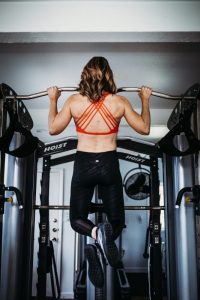
The Pull-Up is a well known compound exercise for training the back. It mostly targets the Latissimus Dorsi (Lats) but many other muscles are targeted like the the middle and lower trapezius, rhomboids, pectoralis major and minor, deltoids, infraspinatus, teres major, biceps brachialis, and the brachioradialis just to name a few! Talk about a lot of bang for your buck! Most people however cannot do a pull up without assistance.
If you haven’t mastered the pull up yet, here is a great progression program to accomplish your first pull-up (and many more):
- Dead hang- grip the bar and hang from it with your arms fully extended. This will build grip strength and core body tension. Once you can hold the exercise for 30+ seconds move on to #2
- Dead Hang with scap ups- while hanging from the bar now focus on retracting your shoulders to engage your back. Once you can hold the exercise for 30+ seconds move on to #3
- Isometric Flexed Arm Hang- hold yourself at the top of the pull-up exercise with your chin over the bar. Use a stool or chair to help get you up on the bar. Once you can hold the flex hang position for 30 + seconds you are ready to move on to #4
- Negative Pull Ups- involves performing the lowering phase (the eccentric portion) of the pull-up exercise. This is the easiest portion of the pull-up exercise. Start with the help from a stool or chair again and get your chin above the bar. Slowly lower yourself down until your arms are straight. Start the eccentric phase with a 5 count and gradually increase to a 10 count. Start with 3 sets of 4 reps and work your way up to 3 sets of 8 reps. Then move on to #5.
- Band Assisted Pull Ups- Resistance bands are available in various sizes and thickness to help support your body weight to make the exercise possible. Loop the resistance band once around the pull up bar in a knot so that it’s secure when you pull it. Grab onto the pull up bar with one hand on each side of the bar and put both feet in the bottom of the band. Starting with your arms fully extended, pull yourself up to the bar so that your chin ends up over the bar. As you get stronger you will be able use the lighter resistance bands for less support. Once you can do 3 sets of 10 with good form and the lightest resistance band move onto #6
- THE PULL UP!!!- grip the bar with your palms facing away from you and your hands about shoulder-width apart. The first motion is depressing your shoulders or pulling them down, trying not to bend your arms. Lead with your chest on the way up, pulling your elbows down and to the floor. Do not let your elbows flare out. Keep your shoulders back and away from your ears. Don’t look up at the bar and do not over-arch your lower back. At the top try to get your chin over the bar keeping your head in neutral alignment. On the way down lower yourself all the way down until your arms are straight at the bottom. YOU DID IT! CONGRATULATIONS!!!
Don’t forget to include other back strengthening exercises in your routine like:
- Dumbbell Rows/Barbell Rows
- Lat Cable Pull Downs
- Dumbbell Pullovers
- Seated Cable Rows
Increasing your grip strength is another important factor to successfully doing a pull up. This includes bicep work like hammer curls and dead-lifts.
Happy Training;
Kristine
